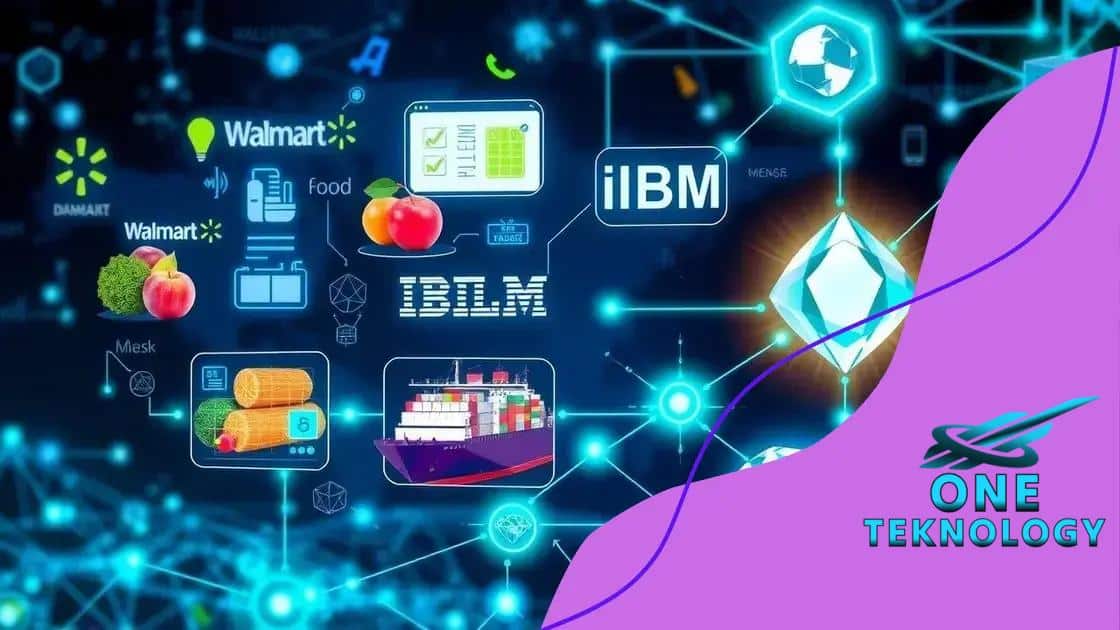How blockchain is revolutionizing supply chain management

Blockchain is revolutionizing supply chain management by enhancing transparency, increasing efficiency, improving security, and enabling real-time tracking of products, thus ensuring greater accountability and trust among all stakeholders.
How blockchain is revolutionizing supply chain management is a topic worth exploring. Have you ever wondered how this technology can enhance transparency and efficiency in logistics? Let’s dive in!
Understanding blockchain technology
Understanding blockchain technology is essential for grasping its role in transforming supply chains. If you have ever wondered how digital records are maintained securely, you’re in the right place. Blockchain offers a revolutionary way to track and verify transactions in real-time.
The core of blockchain lies in its decentralized nature. Unlike traditional databases, where a single entity controls the data, a blockchain is shared across a network of computers. This makes it incredibly difficult to manipulate or alter any information. It also ensures that all participants in the network have access to the same data, fostering trust among parties.
Key Components of Blockchain
Understanding the main components of blockchain technology can help clarify how it operates:
- Blocks: These are the individual units that store data. Each block contains transaction information, a timestamp, and a cryptographic hash of the previous block.
- Chain: The blocks are linked together in a chronological order, forming a secure chain. This prevents any alterations or tampering.
- Nodes: These are the computers that participate in the blockchain network. Each node has a copy of the entire blockchain, contributing to its security and reliability.
Moreover, blockchain uses cryptography to secure data. This involves complex algorithms that ensure only authorized users can access specific information. As a result, blockchain technology allows for higher security levels compared to conventional methods. Additionally, every transaction is recorded transparently, enabling all participants to verify their authenticity.
Why Blockchain Matters for Supply Chains
Implementing blockchain in supply chains can significantly enhance efficiency. For instance, companies can track products from the manufacturer to the consumer effortlessly. This level of visibility is especially crucial for industries like food and pharmaceuticals where safety and authenticity are paramount.
In conclusion, as we explore the potential of blockchain technology, it’s evident that this innovative approach can lead to more reliable and efficient supply chain management.
Key benefits of blockchain in supply chains
Blockchain technology has a range of advantages that can directly impact supply chains. Understanding the key benefits of blockchain in supply chains helps businesses grasp how it could reshape their operations.
One of the most significant advantages is increased transparency. With each transaction recorded on a public ledger, all parties involved in the supply chain can see and verify information. This transparency helps build trust between consumers and businesses.
Improved Traceability
Another vital benefit is the improved traceability that blockchain provides. Companies can easily track the origin of products and their journey through the supply chain. This capability is particularly important in industries like food and pharmaceuticals, where knowing the source of goods can prevent contamination and ensure safety.
- Real-time updates: Stakeholders receive immediate information on product status.
- Recall readiness: Quick identification of affected products simplifies recalls.
- Quality assurance: Transparency allows for better monitoring of product quality.
Cost reductions are another critical benefit. Although there may be initial investments to implement blockchain, over time, companies can save money by eliminating intermediaries and reducing paperwork. These savings can then be redirected towards other areas of the business.
Enhanced Security
Additionally, blockchain offers enhanced security. It uses cryptographic techniques to protect data, ensuring that only authorized individuals can access sensitive information. This security feature makes it challenging for fraudsters to alter or manipulate the data. As a result, businesses can rely on accurate records.
Finally, blockchain technology encourages greater collaboration among supply chain partners. When all parties have access to the same data, it fosters an environment of cooperation and improves decision-making overall. This unity can lead to more efficient operations and enhanced customer satisfaction.
Real-world applications and case studies

The real-world applications and case studies of blockchain in supply chain management illustrate its transformative potential. Companies worldwide are successfully leveraging blockchain to enhance their operations, reduce fraud, and improve overall efficiency.
A notable example is Walmart, which uses blockchain to track food products from suppliers to stores. This application allows Walmart to trace the origin of food items quickly, ensuring safety and quality. If there is a contamination issue, the company can identify the affected products and remove them from shelves almost instantly.
Case Study: IBM Food Trust
Linked to Walmart, the IBM Food Trust network exemplifies how multiple stakeholders in the food industry can collaborate seamlessly. The blockchain solution enhances transparency among suppliers, retailers, and consumers. By enabling all parties to access the same information, the system builds trust and reduces inefficiencies in the supply chain.
- Real-time visibility: Participants can see product movements and statuses at every stage.
- Faster recalls: Companies can quickly pinpoint sources of contamination during food safety issues.
- Better inventory management: Streamlined data assists in managing stock levels effectively.
Another example is Maersk, the largest shipping company in the world, which collaborates with IBM to explore blockchain technology for shipping logistics. By using blockchain, Maersk aims to digitalize and simplify the shipping process, providing transparency and reducing delays caused by paperwork.
Case Study: De Beers
Furthermore, De Beers has implemented blockchain to track the provenance of diamonds, ensuring that they are conflict-free. This initiative helps consumers make informed choices, knowing their purchases do not fund conflict or human rights abuses. The company’s platform allows customers to trace their diamonds from the mine to the retailer, reinforcing ethical sourcing.
Overall, these examples showcase how blockchain is not just a theoretical concept but a powerful tool in real-world supply chains. Companies are making strides towards more transparent, efficient, and secure operations.
Challenges of implementing blockchain
Despite the many advantages, there are significant challenges of implementing blockchain in supply chains. Understanding these challenges is crucial for companies considering a transition to blockchain technology.
One major challenge is the high initial costs associated with setting up blockchain systems. Developing and integrating new technology can require substantial investment in software, hardware, and training. Smaller organizations may struggle to find the necessary resources to implement such systems.
Regulatory Issues
Another hurdle is the lack of regulatory clarity. Many industries still operate under traditional regulations that may not account for blockchain technology. This uncertainty can make it difficult for companies to navigate compliance and legal frameworks. As laws evolve, businesses must stay updated on changes that can affect their blockchain operations.
- Data privacy concerns: Companies must balance transparency with the need to protect sensitive information.
- Interoperability: Ensuring different blockchain systems can communicate with each other is crucial for widespread adoption.
- Stakeholder resistance: Not all participants in the supply chain may be willing to adopt or trust a new system.
Moreover, integrating blockchain with existing systems presents its own set of challenges. Many businesses rely on legacy systems that may not easily connect with new blockchain technologies. This integration can lead to technical complications, requiring significant changes to current processes.
Cultural Resistance
Cultural resistance is another important factor. Employees and managers must understand and embrace blockchain technology for it to be successful. This requires extensive training and a shift in mindset, which can take time and effort.
Ultimately, while the potential benefits of blockchain in supply chains are considerable, the challenges of implementing it are real and should not be underestimated.
Future trends in supply chain innovation
The future trends in supply chain innovation are set to transform industries significantly. Companies are increasingly adopting advanced technologies to enhance efficiency, transparency, and responsiveness in their supply chains.
One major trend is the continued integration of artificial intelligence (AI) and machine learning. These technologies analyze vast amounts of data to predict demand accurately and optimize inventory levels. By using AI, companies can make better decisions and reduce waste. This leads to improved customer satisfaction because products are available when needed.
Increased Automation
Another growing trend is the rise of automation in supply chains. Robotics and automated processes expedite tasks such as sorting, packing, and shipping. This shift not only improves efficiency but also allows human workers to focus on more complex tasks that require critical thinking.
- Warehouse robots: These machines handle various tasks, from inventory management to delivery.
- Drones: Drones are being tested for faster deliveries, especially in hard-to-reach areas.
- Automated vehicles: Self-driving trucks may soon transport goods, reducing reliance on human drivers.
Furthermore, the adoption of the Internet of Things (IoT) is revolutionizing supply chain visibility. IoT devices track shipments in real-time, providing data on conditions, locations, and estimated arrival times. This connectivity enhances transparency across the supply chain, allowing companies to respond quickly to disruptions or delays.
Sustainability Focus
Another trend shaping the future of supply chains is an increased focus on sustainability. Consumers are more conscious of environmental issues, pushing companies to adopt greener practices. This includes reducing carbon footprints, minimizing waste, and investing in sustainable materials.
Lastly, blockchain technology continues to gain traction. As companies seek to improve traceability and eliminate fraud, blockchain offers the perfect solution. By securely recording transactions on a decentralized ledger, businesses can gain complete visibility of their supply chains.
FAQ – Frequently Asked Questions about Blockchain in Supply Chain Management
How does blockchain improve supply chain transparency?
Blockchain allows all parties in the supply chain to see the same data, increasing trust and accountability.
What are the main benefits of using blockchain in supply chains?
The main benefits include enhanced transparency, improved efficiency, better security, and cost savings.
What challenges do companies face when implementing blockchain?
Companies may encounter high initial costs, regulatory uncertainty, and integration issues with existing systems.
What future trends should we expect in supply chain innovation?
Future trends include greater automation, increased use of AI, a focus on sustainability, and more adoption of IoT and blockchain technology.



